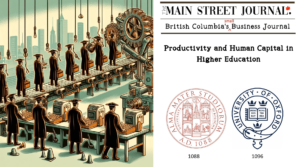Canadians log more hours than other countries but the workforce is less productive. What gives?
Bloatware in Canadian Colleges – YouTube.com
Despite their assertions about developing critical thinking skills in graduates or protecting the public interest, our education industry seems to have succumbed to a sales culture and growth at-all-costs model more in keeping with private sector businesses than quasi-public organizations.
Canadian demographics have shifted in a big way over the past 40 years. In the 1980s, there were about 3 young college-aged adults for each senior aged 65 or more in Canada. Today that ratio has been reversed. To keep increasing enrolments, our colleges have looked to international students to fill the gap and pay the bills.
How can Canadian colleges meet growth targets with a shrinking population?
Canadian Colleges aim to Attract International Students in Response to Changing Demographics.
Just a few days ago the New York Times looked at the role of international students in Canada[1]. According to the article:
“Northern College traditionally drew its students from the province of Ontario’s vast, sparsely populated hinterland, a region dominated by miners and loggers. Today, a whopping 82 percent of the public college’s students come from abroad — nearly all from India.
Northern — and other colleges and universities in Canada — began aggressively looking overseas. The Canadian government said it was on track to host 900,000 foreign students this year, three times as many as a decade ago.”
“But despite many foreign students’ initial reluctance to study at a place as remote as Northern, Dr. Penner, the college’s president, believed she held an ace: Graduates of Northern and other public colleges may apply for a post-graduation work permit that could lead to permanent residence and citizenship.
We can say, if you come here, we can pretty well guarantee that you could stay here and live and make a home for yourselves,” Dr. Penner said.”
In effect, Canada’s public colleges are selling permanent residency to international students. In other words, Canada has outsourced their immigration services to our public colleges. If anyone dares challenge this situation or question how this serves the public interest, they’re accused of being anti-immigrant or racist.
A few days later on Christmas Day, the Times of India[2] picked up on the story:
“Public colleges and universities, hit hard by budget cuts, have grown dependent on the higher tuitions international students must pay. For students from abroad, the institutions can be a conduit to permanent Canadian residence, and for Canada, the students help reduce labor shortages and increase the country’s flagging productivity.”
Can we really expect them to help increase Canada’s productivity?
[1] In Remote Canada, a College Becomes a Magnet for Indian Students
[2] The Times of India copies most of the article




















